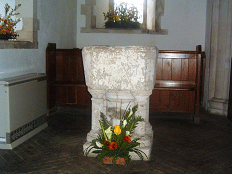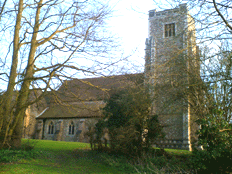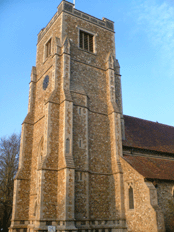|
 There was possibly a small wooden chapel here in Saxon times, but the first evidence is a charter of William II in 1094, establishing a church at Gt. Sampford with a chapel of ease in Hempstead, with the tithes going to William the Conqueror's foundation, Battle Abbey. The only features remaining from this period are the font and the tomb of Dame Margerie de Basingge, who died in 1318. The present building was begun circa 1330, so possibly Dame Margerie left money to rebuild in stone. There was possibly a small wooden chapel here in Saxon times, but the first evidence is a charter of William II in 1094, establishing a church at Gt. Sampford with a chapel of ease in Hempstead, with the tithes going to William the Conqueror's foundation, Battle Abbey. The only features remaining from this period are the font and the tomb of Dame Margerie de Basingge, who died in 1318. The present building was begun circa 1330, so possibly Dame Margerie left money to rebuild in stone.
 The church was consecrated on 8th January 1365, by Simon of Sudbury, then Bishop of London. (He later became Archbishop of Canterbury and was beheaded during the peasants' revolt in 1381. His head can still be seen in the vestry of St. Gregory's church in Sudbury.) He also consecrated the churchyard, to which only a parish church is entitled, so Hempstead was possibly the only church to enjoy the privileges of parish status from 1365 to 1977, when it was united with Radwinter and the diocese legalised the situation. The church was consecrated on 8th January 1365, by Simon of Sudbury, then Bishop of London. (He later became Archbishop of Canterbury and was beheaded during the peasants' revolt in 1381. His head can still be seen in the vestry of St. Gregory's church in Sudbury.) He also consecrated the churchyard, to which only a parish church is entitled, so Hempstead was possibly the only church to enjoy the privileges of parish status from 1365 to 1977, when it was united with Radwinter and the diocese legalised the situation.
The church is mainly of the perpendicular style, with several alterations and modifications over the years. Around 1650, Eliab Harvey, brother of the famous Doctor William Harvey (discoverer of the circulation of the blood) excavated a crypt for the family coffins and built over it a chapel and schoolroom (now the vestry) and shortened and rebuilt the chancel in brick.
 In 1882 the 15th century tower fell down rendering the church unusable until 1888, after a restoration programme had been completed. In 1933 the Harveian Society of London gave money for the rebuilding of the tower. When the rebuilding reached nave height, the money ran out and they were £1,000 short. When the tower was completed in 1960, it cost £14,000!! In 1882 the 15th century tower fell down rendering the church unusable until 1888, after a restoration programme had been completed. In 1933 the Harveian Society of London gave money for the rebuilding of the tower. When the rebuilding reached nave height, the money ran out and they were £1,000 short. When the tower was completed in 1960, it cost £14,000!!
In 1883 the Royal College of Physicians removed William Harvey's coffin from the crypt and placed it in a Carrara marble sarcophagus in the Harvey chapel, leaving 49 other members of the family in the crypt.
Alan Weedon
Further information on the Harvey family can be found Here |

